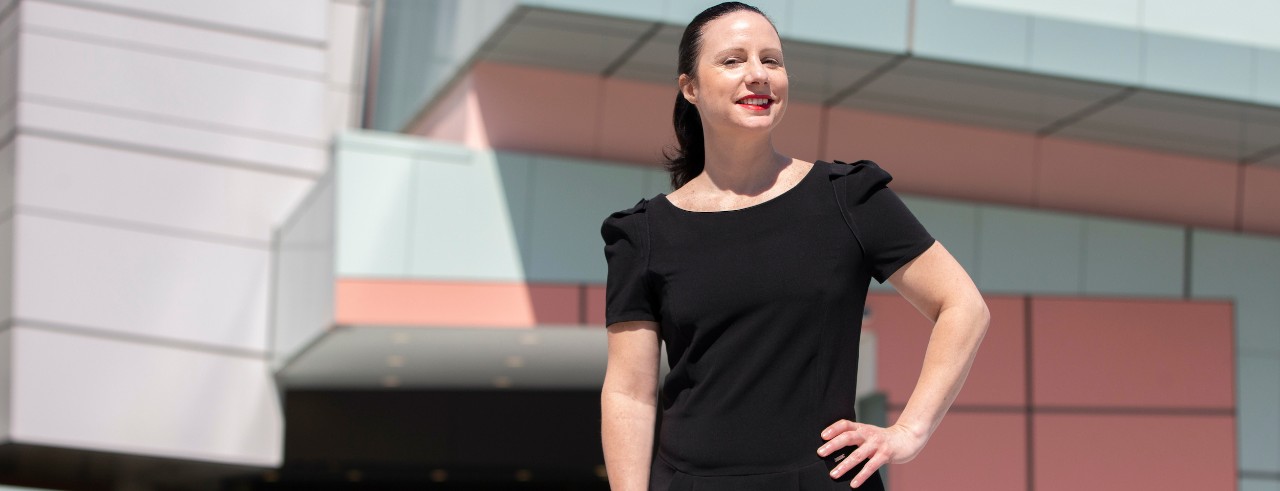
UC Answers: How is UC using design to address COVID-19?
Associate dean is part of UC team designing pandemic solutions
Claudia Rebola is an associate professor and the associate dean for research at the University of Cincinnati’s College of Design, Architecture, Arts, and Planning. She is part of a UC team using innovation and design expertise to respond to COVID-19.
What is the COVID-19 Design Innovation team?
The team was born at the core of the university to operate as a hub for innovation between DAAP and other UC colleges including the College of Engineering and Applied Science, the Office of Innovation, the 1819 Innovation Hub, UC Medical Center, UC Health, Cincinnati Children’s Hospital Medical Center and a number of local organizations such as TriHealth, Sew Valley, Sew Masks 4 Cincy, Fechheimer, Scrubs and Beyond, the Cincinnati sheet metal workers union and many others.
In early March, we were faced with the harsh realities that hospitals were running out of critical supplies. Everyone was looking for ways to get involved and help with the crisis — especially our students and faculty at UC. In an effort to connect designers, innovators and health care professionals, we formed a team of passionate individuals to ideate, test and manufacture solutions to help address the COVID-19 crisis.
What has the team produced?
Several products were brought about through the initiative, including personal protective equipment (PPE) (several different kinds of masks and face shields), respirators, ventilators components, thermometers, nasal swabs and more. We even created a face shield from office supplies and produced several hundred in a matter of weeks.
How did you work together to create solutions?
DAAP design faculty, including Steven Doehler and Ashley Kubley, and Ben Jones from the 1819 Innovation Hub drove the design process while setting up micromanufacturing operations combined with students and other volunteers into a factory seemingly overnight. When we realized we weren't going to be able to generate the supplies fast enough, we shifted focus to community organizations and helped to coordinate a distributed manufacturing effort that dramatically increased the volume the team was able to produce.
We received material donations from local companies and health care providers to help us quickly make PPE. Nick Germann, lab manager of DAAP's Rapid Prototyping Center, helped to design, cut and fabricate many of the masks. It was truly an "all hands on deck" operation. Some of the masks were created from sterile up-cycled materials that would have otherwise been discarded. This quick response was necessary, because in the first critical weeks, material supply chains were at a standstill.
What role have students played in this work?
They played a major role; they wanted to help in any capacity. Kubley mobilized students in the fashion design program to produce face masks.
Graduate students were instrumental in designing PPE and getting feedback from UC experts and health care professionals. Ryan Norton, a DAAP Master of Design degree candidate, got involved with the Cincinnati health care system TriHealth and soon after we were joining their innovation calls to listen to medical provider needs and develop effective PPE designs. Literally by the next day, for example, TriHealth had one of my PPE face shield prototypes in their hands for testing. Norton worked with hospital staff to adapt existing respirators to patient-facing protective masks.
Kubley mobilized students in the fashion design program to produce face masks. Doehler engaged industrial design faculty to assemble disposable masks, and a group of more than 50 fashion design students, faculty and DAAP staff used their home machines and sewing skills to help us prepare and sew/assemble many of the masks.
Our team set up production and assembly kits, as well as pickup and turn-in sites to involve students and faculty off campus. We quickly developed a pickup/dropoff packet system with TriHealth to safely facilitate the assembly. Without the help of undergraduate and graduate students as well as faculty and staff, we couldn’t have reached the production volume.
What UC facilities were used for production?
The 1819 Innovation Hub and DAAP facilities like the Fashion Technology Center and the Rapid Prototyping Lab were open, under the approval of the UC Office of Research and its safety protocols, to produce and assemble the designs. We turned our vacated classrooms into assembly spaces to help with the demand.
What have you learned from this experience?
Overall the message is that COVID-19 taught us to behave as a community. Roles blended, common purpose was found, focused and timed innovation occurred. Fluid communications were key as well as using our expertise to engage communities for action. While challenges were imposed by time and production, the crisis helped coordinate efforts and we became agile networks of stakeholders working towards a common goal, hacking the crisis by design.
Featured image at top: Claudia Rebola poses outside DAAP. Photo/Joseph Fuqua II/UC Creative + Brand
Get involved
The COVID-19 Design Innovation team meets via Microsoft Teams to check in, share ideas and ask clinicians to identify problems that need solutions. To join the initiative, email COVID19DI@uc.edu.
Find more UC Answers to your important questions.
Related Stories
UC study finds vision loss fear may keep some from having...
April 23, 2025
A new University of Cincinnati study finds vision loss fears may deter some patients from cataract surgery, despite it being the only effective treatment. The research underscores the role of doctor-patient relationships in medical decisions.
Launching lives: UC Clermont manufacturing program to offer paid...
April 23, 2025
The University of Cincinnati Clermont College’s Manufacturing Engineering Technology program will soon prepare students for the real world more than ever — through a new cooperative education requirement for those entering the program in fall 2025.
‘This is rocket science’
April 23, 2025
At the University of Cincinnati’s Hypersonics Lab, students pursue new technology for high-speed travel and exploration.
